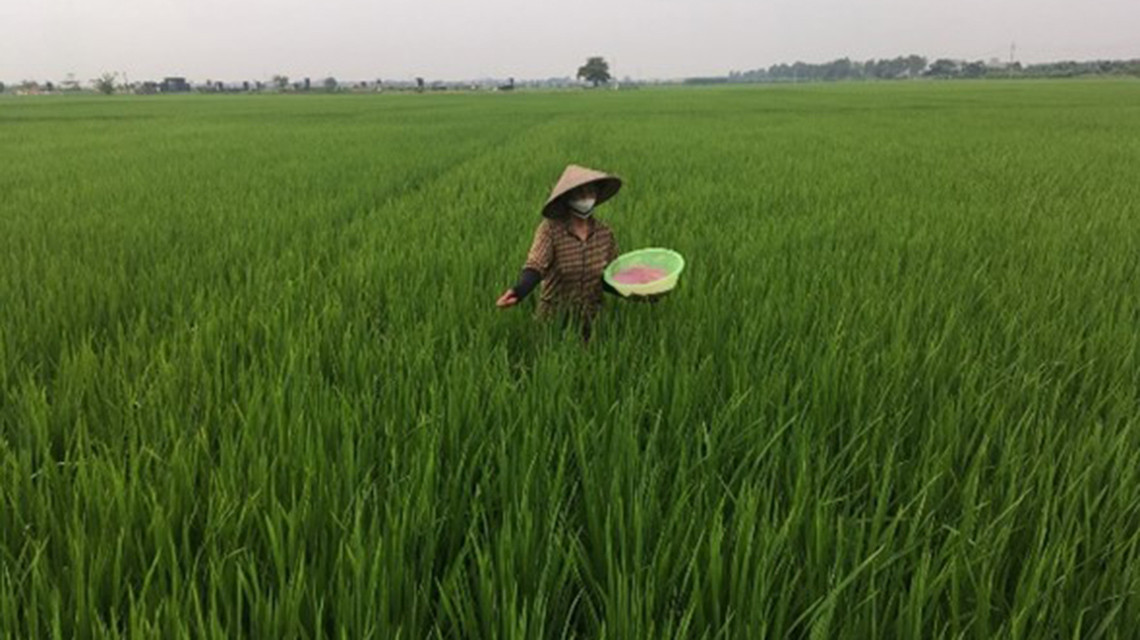To achieve sustainable rice production and food security in the region, farmers in six Asian countries have used nuclear derived climate-smart agricultural practices and significantly increased their rice yields, with the help of the IAEA and the Food and Agriculture Organization of the United Nations (FAO).
Rice is a food staple for 60 per cent of the Asian continent, with about 90 per cent of the global rice crop grown and consumed in Asia. Rice farming in the region uses over 135 million hectares and directly employs more than 300 million people in its cultivation and production. The shortages in water and the impacts of climate change have created a deficit in rice production. Increasing rice production in the region is important to ensure food security, meet the demands of a growing population and improve farmers livelihoods.
Groups of farmers in 11 countries across Asia have been using climate-smart agricultural practices following training on nuclear and isotopic techniques, under the IAEA's technical cooperation programme. Farmers in Bangladesh, Lao People's Democratic Republic, Myanmar, Nepal, Pakistan, and Viet Nam saw particular success with rice production increased from 1 to 2.5 tons per hectare.
Scientists from the Joint FAO/IAEA Centre of Nuclear Techniques in Food and Agriculture have made endeavours to harness nuclear techniques to optimize fertilizer and water use, thereby increasing the efficiency of agricultural production while maintaining soil health. These technologies have been successfully adopted by our counterparts and farmers in various countries, which helped increase agricultural productivity and profitability in a sustainable manner.

A farmer in Viet Nam applies a second top-dressing fertilization. (Photo: Viet Nam Academy of Agricultural Sciences)
For example, farmers in Pakistan's Punjab and Sind provinces were trained to employ climate-smart agriculture technologies based on this research to optimize productivity, such as the perfect mix of combining chemical and organic fertilizer for local soils and crops - known as the IAEA/FAO Integrated Option.
This led to their basmati rice yield increasing by 188 per cent, while long-grain rice increased by 176 per cent in field trials conducted in six regions of Khyber Pakhunkhwa, Punjab and Sind provinces. By increasing rice production, farmers enhance food supply and security in their region while promoting sustainable farming practices that can be replicated by other countries.
"The IAEA recommended the use of these innovative practices which increases farm productivity, providing me with extra income," said Babul Hossain, a farmer in Bangladesh. "The practice has become popular and encouraging to other local farming communities."
The joint IAEA/FAO approach to climate-smart agriculture also reduced ammonia emissions by around 36 per cent in rice, according to Mohammad Jahangir, a professor at the Bangladesh Agricultural University who has been carrying out climate-smart agriculture trials in farmers' fields across the country. "Under the climate-smart agriculture approaches, the soil became fertile and resilient against climate stress," he added. Reducing ammonia emissions decreases air pollution, protects human health and helps prevent harm to the ecosystem.
"The increase in productivity following the IAEA Integrated Option exemplifies how combining chemical and organic fertilizers can lead to higher yields and better soil health, paving the way for a future where food security and environmental sustainability co-exist harmoniously" said Javed Shah, a scientist at Nuclear Institute of Agriculture (NIA), Tandojam, Pakistan.
"Nuclear science and technology play a key role in developing climate-smart agriculture. The result of the climate smart rice production towards sustainability and regional food security through nuclear and modern technology demonstrates the potential of climate-smart agriculture practices in increasing rice productivity and promoting sustainable farming, which can be replicated worldwide," said Mohammad Zaman, Head of the Soil and Water Management and Crop Nutrition Section at the Joint FAO/IAEA Centre of Nuclear Techniques in Food and Agriculture.

Participants during the training on laboratory analysis in Myanmar. (Photo: Myanmar Department of Biotechnology)
In 2018, the Joint FAO/IAEA Centre developed the Rice Production Guidelines, which provide farmers with the best management practices based on results obtained using isotopic techniques. By applying these enhanced crop management methods, farmers can improve the rice productivity and food security in their region.
The climate-smart rice production towards sustainability and regional food security through nuclear and modern technology project aims to develop climate- smart agriculture practices to combat climate change, mitigate greenhouse gas emissions, enhance soil fertility, and increase rice productivity in a sustainable manner.
The Joint FAO/IAEA Centre of Nuclear Techniques in Food and Agriculture supports countries in applying nuclear and related techniques to increase agricultural productivity sustainably, adapt and build the resilience of agrifood systems to climate change, and reduce greenhouse gas emissions in agriculture, considering national and local specificities and priorities.
To help boost global food production and food security, the IAEA and FAO launched the Atoms4Food initiative in 2023 to expand the use of innovative nuclear techniques to enhance agricultural productivity, ensure food safety, reduce food losses and improve nutrition and the challenges of climate change.






